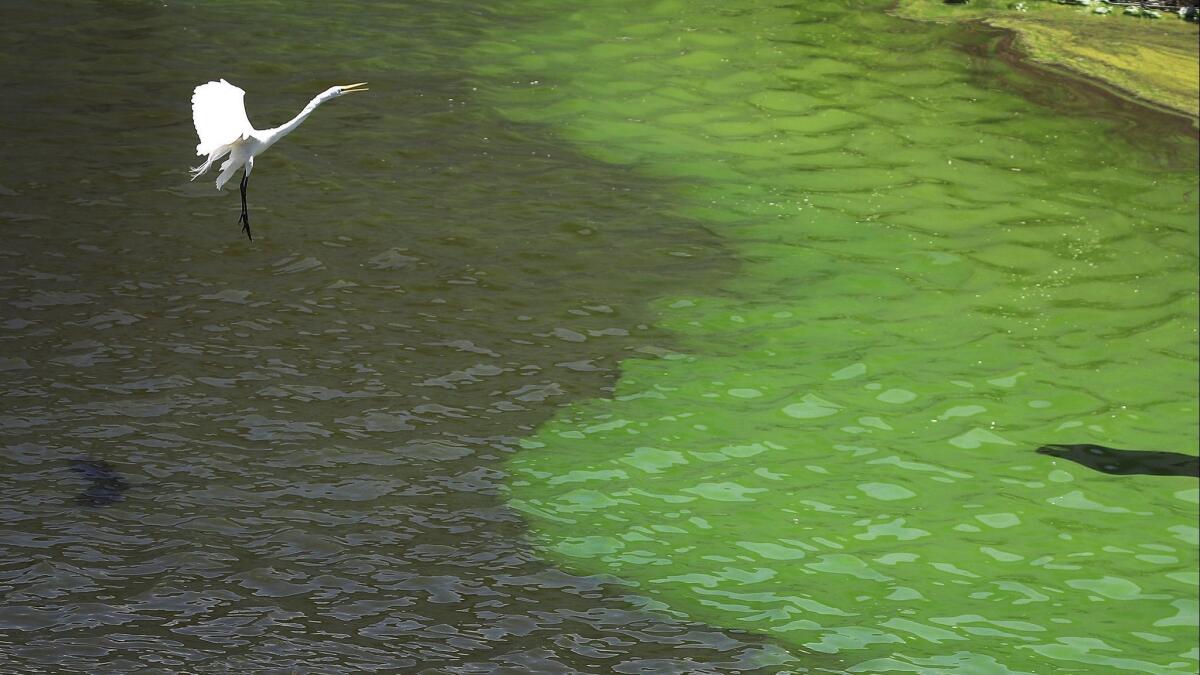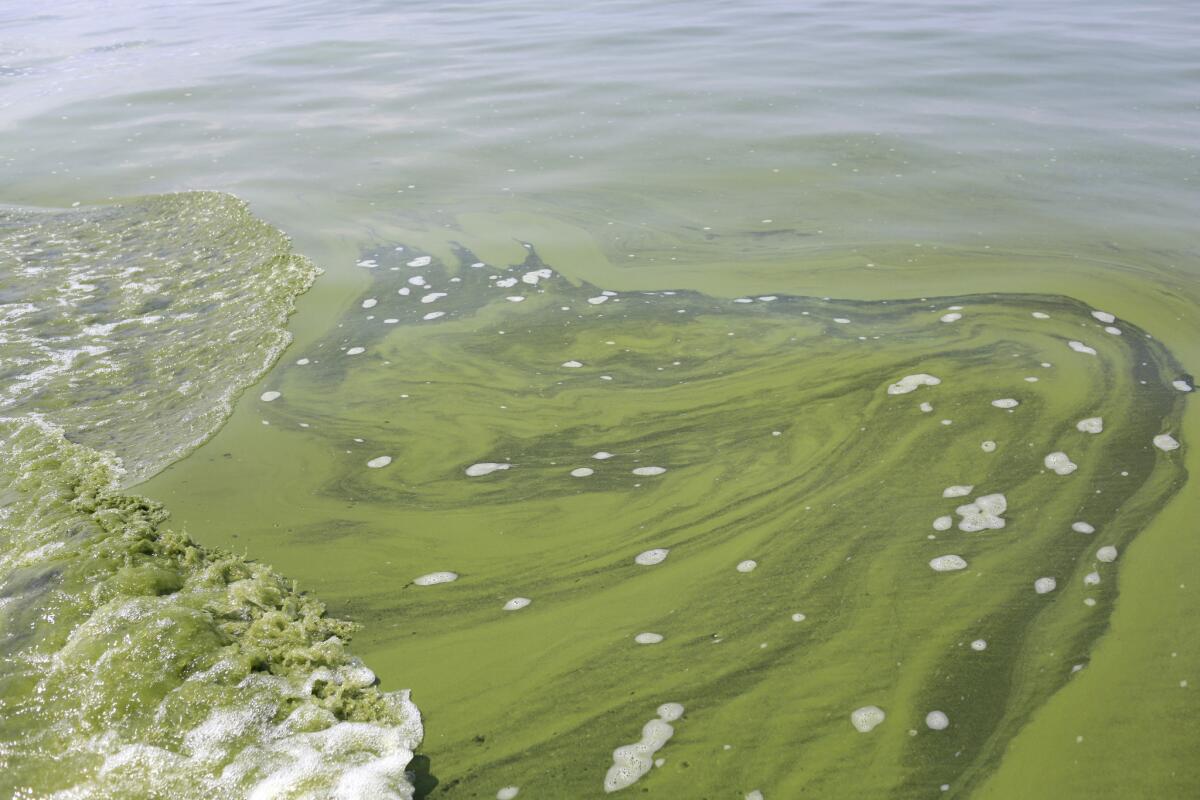Everything you need to know about toxic algae blooms

- Share via
Green pond scum floating on a lake is not just unsightly. As animal lovers have learned the hard way, it can be deadly.
In recent days, three pet dogs in North Carolina and another in Georgia died after swimming in water contaminated with toxic organisms.
Warm temperatures and an influx of nutrients from agricultural runoff or other sources can prompt toxic algae and bacteria to grow out of control. The result is a phenomenon called a toxic algae bloom.
As the planet warms, these blooms are becoming more frequent — leading to a greater chance for human and animal exposure.
Here’s what you need to know to protect yourself and your pets from toxic algae blooms.
What are algae?
Algae are plant-like organisms that grow in water or other damp environments. They can be as small as a single cell or as large as a kelp forest. For the most part, they get their energy through photosynthesis. However, they lack roots, leaves and other characteristic components of plants.

The microorganisms known as blue-green algae aren’t actually algae at all. They are cyanobacteria, bacterial cells that get their energy from photosynthesis.
Toxic blooms in freshwater lakes and streams are usually caused by cyanobacteria, while blooms that occur in the ocean are typically the result of algae.
What is an algae bloom?
A bloom occurs when algae or cyanobacteria suddenly grow to huge numbers. In 2011, for instance, a toxic algae bloom in Lake Erie grew so large over the course of four days that it could be seen from space. This growth is typically fueled by warm temperatures, still water and nutrients such as nitrogen and phosphorous.
Algae blooms can range from completely innocuous to incredibly toxic, said David Caron, a microbial ecologist at USC. They can turn the water different colors, from bright reds and greens to shades of brownish-yellow.

What makes them harmful?
Some species of algae release toxins into their aquatic environment. During a bloom, the concentration of toxins in the water can reach levels that are dangerous for both humans and animals.
The type of toxin released depends on the species causing the bloom. Some of the most common ones affect the liver or the nervous system, said Donald Anderson, director of the U.S. National Office for Harmful Algal Blooms and a senior scientist at the Woods Hole Oceanographic Institute.
“In the ocean at least, there’s about 100 species that can produce known toxins, and there’s a lot of them in freshwater as well,” Anderson said.
Are toxic algae blooms the same as red tides?
Not quite. Red tides are certainly an example of an algae bloom, but although the water may be red, the algae might not be producing toxins. (State public health officials monitor these blooms to check for toxin production.)
Scientists have moved away from using the term “red tide” because it’s not quite descriptive enough. Blooms can produce a variety of colors; they can also be dangerous even when the water isn’t discolored at all, Anderson said.
Can scientists predict when and where they will occur?
Not yet. The precise conditions that result in an algae bloom aren’t completely clear.
“There are a lot of nuances in why blooms occur, when blooms occur, which species bloom and whether they produce toxin,” Caron said. Scientists are trying to understand these factors “so that we can have better predictive ability of when and where blooms will occur,” he said.
Is climate change making these toxic blooms more common?
Absolutely. Global warming is making harmful freshwater blooms more frequent and more dense, Anderson said. They’re also moving farther north and leaving their more southern boundary behind.
“We’re seeing that these problem organisms are changing the ranges in which they occur because of climate,” he said.
In the ocean, patches of warm water are prime real estate for algae blooms.
An increase in water temperature off the west coast of the United States caused a massive toxic algal bloom in 2015. Lethal concentrations of toxins closed fisheries in California and halted clam harvesting in Oregon and Washington.
This bloom was not necessarily a result of global warming, Anderson said. “But it gives you a feeling of what might happen with climate change and warming of waters,” he said.
How are humans exposed to these toxins?
The most common way is through what Anderson calls “recreational exposure.”
“It would be people swimming in a lake and either swallowing water or breathing in aerosolized cells and toxin while they ride on a motorboat or Jet Ski,” he said.
It can show up in our food, too. For instance, fish and shellfish can eat algae that produce the toxin domoic acid. It’s not harmful for them, but it’s toxic to people. High doses can be lethal, according to the National Oceanic and Atmospheric Administration. Lower doses can damage the brain and cause memory loss.
What about dogs?
Unfortunately, dogs can be quite attracted to toxic algae, and pet owners need to be vigilant, Anderson said.
“A lot of these animals just go down to the shore and drink. They’re just used to doing that,” he said. “Sometimes some of these algae dry on the shore of the water and get kind of crispy or crunchy, and dogs will eat that. They tend to like the taste of it.”
The toxin’s effects kick in rapidly in dogs, Caron said, so it’s vital to get to the vet as quickly as possible.
What can people do to protect themselves and their pets?
Be observant. Check for signs indicating that the area is closed to the public. Even if no signs are posted, take a look at the water and make sure the color is normal.
“If you see that slimy green surface to the water, you really should not let your animals go swimming or drinking along the edge,” Anderson said.
If you do come into contact with an algae bloom, “try not to swallow the water,” he said. “Wash really well with hoses because you can get rashes as well.”
Don’t go fishing and don’t harvest shellfish if a harmful algae bloom is underway. Government agencies including state departments of public health keep a close eye on toxin levels, and you can rely on their advice, Anderson said.
“These monitoring programs are truly effective,” he said. “If there are shellfish on the market at a reputable store or restaurant, you can eat them. I eat them all the time.”






